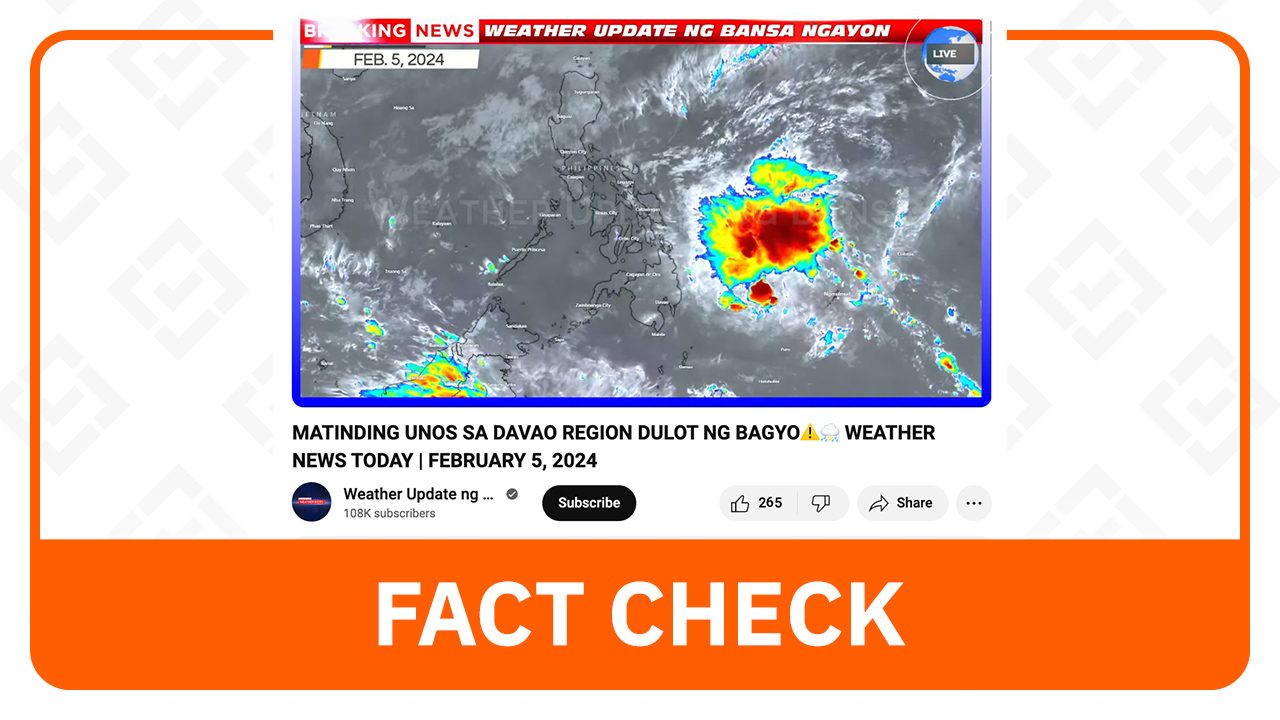SUMMARY
This is AI generated summarization, which may have errors. For context, always refer to the full article.

Claim: A tropical cyclone caused flooding and landslides in the Davao Region in the past week, according to a weather report on Monday, February 5.
Rating: FALSE
Why we fact-checked this: The video containing the claim was posted by a verified YouTube channel named “Weather Update ng Bansa” on February 5. The video has 7,233 views and 269 likes as of writing.
The thumbnail and title of the video bore the claim: “Matinding unos sa Davao Region dulot ng bagyo. Weather news today | February 5, 2024.” (Calamity in the Davao Region caused by a storm. Weather news today | February 5, 2024.)

The facts: Heavy rain due to the trough or extension of a now-dissipated low pressure area (LPA) caused landslides and floods in the Davao Region, according to the Philippine Atmospheric, Geophysical, and Astronomical Services Administration (PAGASA).
PAGASA monitored the LPA outside the Philippine Area of Responsibility (PAR) from January 28 to February 2. Its trough brought heavy rain to parts of Mindanao.
According to the February 5 situation report of the National Disaster Risk Reduction and Management Council (NDRRMC), over 812,000 individuals were affected by the landslides and widespread flooding. At least 16 people died, while 11 were injured and 3 reported missing.
The NDRRMC recorded a total of 222 flooded areas and 42 rain-induced landslides in the Davao Region, Caraga, and the Bangsamoro Autonomous Region in Muslim Mindanao.
Storm-free, so far: No tropical cyclone has formed within or entered PAR so far in 2024. Contrary to the claim in the misleading video, neither a tropical cyclone nor an LPA was being monitored inside or outside PAR as of February 5. Only the easterlies – or warm winds from the Pacific Ocean – and the northeast monsoon or amihan were causing isolated rain.
Outdated report: The misleading video used spliced and edited audio from an outdated PAGASA weather report posted on February 4. This report, however, made no mention of a tropical cyclone or LPA being monitored outside PAR as the earlier LPA dissipated on February 3.
Previous fact checks: Rappler has debunked posts from YouTube channels claiming to report weather updates:
- FACT CHECK: No super typhoon expected in PH up until December 21
- FACT CHECK: No super typhoon Liwayway in PH area of responsibility up until December 19
- FACT CHECK: No new super typhoon to make ‘sure landfall’ in PH up until this week
- FACT CHECK: No super typhoon in PH up until October 24
- FACT CHECK: Signal No. 2 is the highest wind signal for Typhoon Jenny as of 5 pm, October 3
- FACT CHECK: Lumabas na ang bagyong Ineng noong Setyembre 6
- FACT CHECK: Di totoong may 2 bagyong tatama sa Pilipinas ngayong Setyembre 11
- FACT CHECK: Hindi super typhoon ang bagyong Hanna, walang Signal No. 5
Official news: For official weather updates, refer to PAGASA’s official website, X (formerly Twitter), Facebook, and YouTube accounts. Get updates too via Rappler’s Philippine weather page. – Ailla dela Cruz/Rappler.com
Keep us aware of suspicious Facebook pages, groups, accounts, websites, articles, or photos in your network by contacting us at factcheck@rappler.com. You may also report dubious claims to #FactsFirstPH tipline by messaging Rappler on Facebook or Newsbreak via Twitter direct message. You may also report through our Viber fact check chatbot. Let us battle disinformation one Fact Check at a time.
Add a comment
How does this make you feel?




![[Pastilan] The Great Philippine Identity Sale](https://www.rappler.com/tachyon/2024/07/great-philippine-identity-sale-july-16-2024.jpg?resize=257%2C257&crop=486px%2C0px%2C1080px%2C1080px)
There are no comments yet. Add your comment to start the conversation.